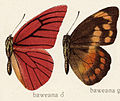
Servius Galba was Roman emperor from 68 to 69, the first emperor in the Year of the Four Emperors. He was known as Lucius Livius Ocella Sulpicius Galba prior to taking the throne as a result of his adoption by his stepmother, Livia Ocellina. The governor of Hispania at the time of the rebellion of Gaius Julius Vindex in Gaul, he seized the throne following Nero's suicide.

Nero Claudius Caesar Augustus Germanicus was the fifth Roman emperor, ruling from 54 to 68. His infamous reign is usually associated with tyranny, extravagance, and debauchery. Nero, originally named Lucius Domitius Ahenobarbus, belonged to the Julio-Claudian dynasty, and was adopted as heir by the emperor Claudius, his great-uncle and stepfather. Nero succeeded Claudius while not yet aged 17, and his mother, Agrippina, tried to dominate his early life and decisions, but Nero cast her off and had her killed five years into his reign.

Marcus Otho Caesar Augustus was Roman emperor for three months, from 15 January to 16 April 69. He was the second emperor of the Year of the Four Emperors.
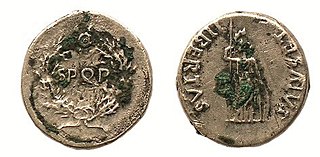
Gaius Julius Vindex, of a noble Gallic family of Aquitania given senatorial status under Claudius, was a Roman governor in the province of Gallia Lugdunensis. He was one of the men belonging to the faction of the powerful mother of Nero, Empress Agrippina and took part in a conspiracy against the emperor in 59. However, with the assassination of Agrippina by Nero, this faction was dissolved.
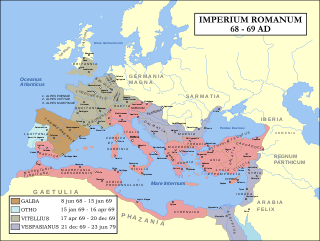
The Year of the Four Emperors, AD 69, was a period in the history of the Roman Empire in which four emperors ruled in succession: Galba, Otho, Vitellius, and Vespasian.

Histories is a Roman historical chronicle by Tacitus. Written c. 100–110, it covers c. 69–96, a period which includes the Year of Four Emperors following the downfall of Nero, as well as the period between the rise of the Flavian Dynasty under Vespasian and the death of Domitian.

Spialia galba, the Indian grizzled skipper, is a hesperiid butterfly which is found in South Asia and parts of Southeast Asia.
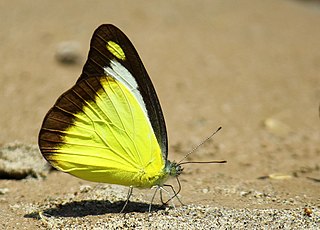
Appias lyncida, the chocolate albatross, is a butterfly of the family Pieridae, that is, the yellows and whites, which is found in south and southeast Asia.
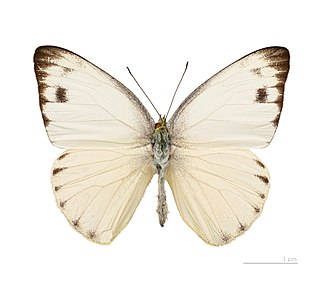
Appias, commonly called puffins or albatrosses, is a genus of butterflies in the subfamily Pierinae (whites) found in Africa and southern Asia.
Gaius Nymphidius Sabinus was a Prefect of the Praetorian Guard during the rule of Emperor Nero from 65 until his death in 68. He shared this office together with Gaius Ophonius Tigellinus, replacing his previous colleague Faenius Rufus. During the second half of the 60s, Nero grew increasingly unpopular with the people and the army, leading to a number of rebellions which ultimately caused his downfall and suicide in 68. Nymphidius took part in the final conspiracy against Nero and persuaded the Praetorian Guard to desert him, but when he attempted to have himself declared emperor, he was killed by his own soldiers.
Cornelius Fuscus was a Roman general who fought campaigns under the Emperors of the Flavian dynasty. During the reign of Domitian, he served as prefect of the imperial bodyguard, known as the Praetorian Guard, from 81 until his death in 86 AD. Prior to this appointment, Fuscus had distinguished himself as one of Vespasian's most ardent supporters during the civil war of 69 AD, known as the Year of the Four Emperors.
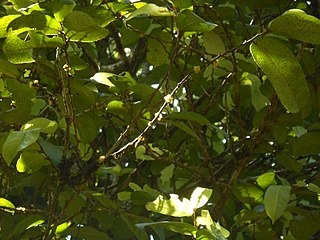
Drypetes oblongifolia is a plant species of the genus Drypetes and the family Putranjivaceae.

Appias olferna, the eastern striped albatross or Bengal albatross, is a butterfly in the genus Appias of the family Pieridae. The species was first described by Charles Swinhoe in 1890.
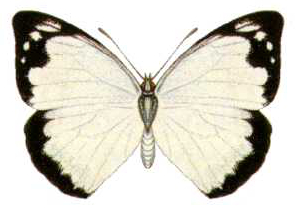
Appias paulina, the common albatross, Christmas Island white or Ceylon lesser albatross, is a butterfly of the family Pieridae. It is found from India to Samoa, including Indonesia, Japan, Malaysia, New Caledonia, Sri Lanka, Thailand and Australia.

Appias sabina, the Sabine albatross or albatross white, is a butterfly of the family Pieridae. It is found in Africa. The habitat consists of forests.
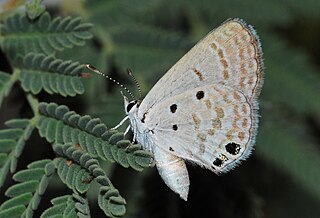
Luthrodes galba, the Persian grass blue, is a butterfly in the family Lycaenidae. It is found in southern Turkey, central and eastern Arabia, Iraq, Iran, Afghanistan, the Caucasus and Cyprus.

The Appian Way Regional Park is the second-largest urban park of Europe, after Losiny Ostrov National Park in Moscow. It is a protected area of around 4580 hectares, established by the Italian region of Latium. It falls primarily within the territory of Rome but parts also extend into the neighbouring towns of Ciampino and Marino.



